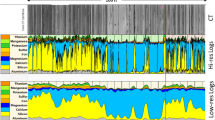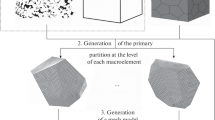Summary
Determination of Permeability in Anisotropic Rock-Masses From Integral Samples
A method is presented which makes it possible to characterize the permeability of a rock mass as an anisotropic magnitude — i. e. to determine its permeability tensor — from a characterization of its fracturing by means of integral samples.
For the purpose, a theory is developed by means of which the permeability tensor can be calculated from the attitudes and openings of the fractures and — if infillings are present — also from their coefficient of permeability. All these magnitudes are determined in integral samples, it being assumed that the sampled fractures are continuous and plane, and have the same characteristics as the section of the fractures present in the samples. Possible deviations with respect to this assumption are taken into account by means of correcting factors derived from the results of pressure tests in situ. The permeability tensor of a rock mass at a point can be determined from a single integral sample, provided this is representative of the fracturing.
Results of the application of the method are presented, which show it to look very promising.
Zusammenfassung
Die Bestimmung der Durchlässigkeit anisotroper Gebirge mit Hilfe von vollständigen Proben (Integral Samples)
Diese Arbeit behandelt eine Methode, die es erlaubt, aufgrund der aus vollständigen Proben erhaltenen Charakterisierung der Gebirgsklüftung, die Gebirgsdurchlässigkeit als anisotropische Größe zu beschreiben.
Zu diesem Zweck wird die theoretische Grundlage erarbeitet, mit deren Hilfe der Durchlässigkeitstensor aufgrund der Kluftstellung und -öffnungen (und im Falle von Kluftfüllungen auch der entsprechende Durchlässigkeitsbeiwert) berechnet werden kann. Diese Größen werden an den vollständigen Proben ermittelt, wobei die erwähnte Theorie auf der Annahme beruht, daß die Klüfte eben und durchlaufend sind, und immer das gleiche Bild aufweisen, wie das der Probenschnitte. Um etwaige Abweichungen dieser Annahme berücksichtigen zu können, werden Berichtigungsfaktoren eingeführt, die aufgrund von „in situ“-Druckversuchen ermittelt werden. Für die Bestimmung des Durchlässigkeitstensors an einem Punkt des Gebirges wird nur eine vollständige Probe benötigt, vorausgesetzt, daß diese für die Klüftung repräsentativ ist.
Es werden Anwendungsbeispiele erläutert, die zeigen, daß diese Methode sehr vielversprechend ist.
Résumé
Détermination de la perméabilité des massifs rocheux anisotropiques à partir d'échantillons intégraux
On présente une méthode permettant la caractérisation de la perméabilité des massifs rocheux comme une grandeur anisotropique — c'est-à-dire permettant la détermination du tenseur perméabilité — à partir de la caractérisation de la fissuration du massif au moyen d'échantillons intégraux.
Pour cela, on établit une théorie au moyen de laquelle on peut calculer le tenseur perméabilité à partir de l'attitude et de l'ouverture des fissures, et du coefficient de perméabilité du remplissage, s'il y en a. Toutes ces grandeurs sont déterminées sur des échantillons, en admettant que les fissures sont continues et planes, et qu'elles ont les mêmes caractéristiques que les sections des fissures contenues dans les échantillons. Afin de tenir compte de déviations possibles à l'égard de l'hypothèse admise, on introduit des facteurs de correction obtenus au moyen d'essais sous pression in situ. Pour déterminer le tenseur perméabilité, il suffit d'avoir un seul échantillon intégral, pourvu que celui-ci soit réprésentatif de la fissuration.
On présente des résultats d'applications de la méthode, selon lesquels celle-ci se montre très prometteuse.
Similar content being viewed by others
References
Bogomolov, G. V., and A. I. Silin-Bektchourine: Hydrologie Spécialisée, Annales du Service d'Information Géologique,37, Paris 1959.
Franciss, F. O.: Contribution à l'étude du mouvement de l'eau à travers les milieux fissurés, Thèse Doctorat, Faculté des Sciences, Université de Grenoble, 1970.
Franciss, F. O., and A. L. Puccini: Técnica de identificação de grupamentos modais e sua aplicação na mecânica das rochas, Rio de Janeiro, 1974.
Louis, C.: A Study of Ground Water Flow in Jointed Rock and Its Influence on the Stability of Rock Masses, Imperial College, Rock Mechanics Report, 10 Sept. 1969.
Louis, C.: Rock Hydraulics, Bureau de Recherches Géologiques et Minières, Orléans, 1974.
Rocha, M.: A Method of Integral Sampling of Rock Masses, Rock Mechanics,3 1 (1971).
Rocha, M., and M. Barroso: Some Applications of the New Integral Sampling Method in Rock Masses, Rock Fracture Symp., Int. Soc. for Rock Mech., Nancy, 1971.
Schneebeli, G.: Hydraulique Souterraine, Eyrolles, 1966.
Snow, D. T.: Three-Hole Pressure Test for Anisotropic Foundations Permeability, Rock Mech. and Engg. Geology,4 4 (1966).
Author information
Authors and Affiliations
Additional information
With 16 Figures
Rights and permissions
About this article
Cite this article
Rocha, M., Franciss, F. Determination of permeability in anisotropic rock-masses from integral samples. Rock Mechanics 9, 67–93 (1977). https://doi.org/10.1007/BF01237875
Received:
Issue Date:
DOI: https://doi.org/10.1007/BF01237875




